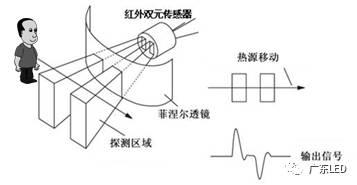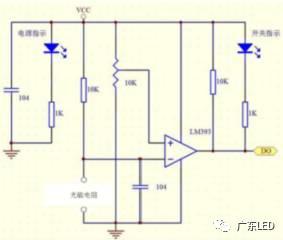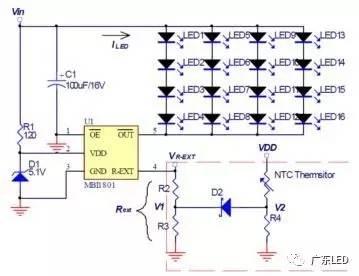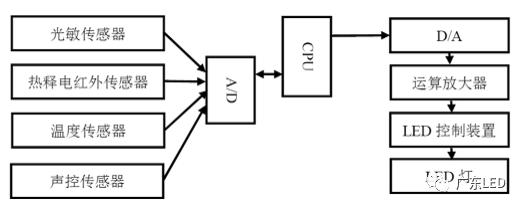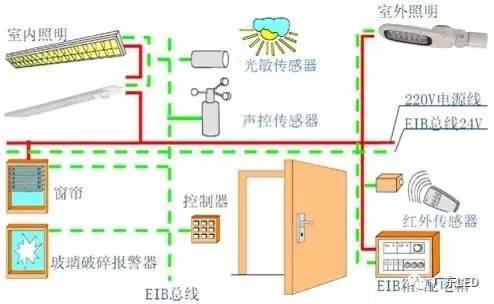Describe the sensor technology with " LED + smart" lighting for system management, from the working principle, hardware and software design schemes reflect the important role of sensors in intelligent LED lighting systems. Predicting the integration of LED lighting with more sensors and wireless communication technologies is widely used to make people feel a more comfortable light environment. introduction With the improvement of people's living standards, colorful LEDs (LEDs) are widely used in home lighting, commercial lighting, public lighting and landscape lighting. Various sensors and intelligent control systems are used in LED lighting. The role played by the secondary energy saving is fully reflected. The sensor plays the role of transmitting information and interaction in the “LED+Intelligent†lighting system, effectively controlling the lighting time of the lamp to save energy, and is also an important part of realizing intelligent control. This article focuses on the combination of "LED + smart" lighting and sensing technology. In order to provide people with a comfortable light environment and sustainable energy conservation, lighting products are being transformed from traditional single lighting to intelligent lighting systems, various sensors and LED lighting products match the eyes that act as intelligent control systems. For example, in the field of public lighting, LED street lamps use light-sensitive sensors to realize light control according to the daylight cycle. Infrared sensors collect people's activity information to realize people's running out of lights, making our life more energy-saving and environmentally friendly. The combination of “LED+Intelligent†lighting and sensing technology Applications will subvert traditional lighting concepts. 1. Overview of sensing technology In order to obtain information from the outside world, people must rely on sensory organs. In the process of information transmission, the first thing to be solved is to obtain accurate and reliable information. Transducers are the main ways and means to obtain information in the natural environment and corresponding work processes. The national standard GB/T7665-2005 "General Terms of Sensors" defines a sensor: a device or device that can be measured and converted into usable output signals according to a certain rule, usually composed of sensitive components and conversion components. 1.1 Typical sensor (1) pyroelectric infrared sensor: pyroelectric infrared sensor (passivelnfrared ray) is a thermosensitive infrared sensor with pyroelectric material, which can convert the infrared radiation energy of the filter optical film into electrical signal. . The working principle is shown in Fig. 1. When the surface temperature of the detector is not changed, the internal charge is neutralized with the surface adsorption charge, and the temperature of the detector is kept balanced by T[K]. If the temperature of the external infrared radiation is changed, the sensitive element will change T+T [K], that is, when the external infrared radiation causes the temperature change of the sensitive element surface of the detector, the sensor will release the current. When the temperature is stable, the internal current is balanced, the sensitive element has no current, and there is no current output to the relatively stationary heat source. By using the pyroelectric infrared detector, an infrared heat source such as a human motion can be detected. The class sensor is a passive temperature sensitive device that has low ambient temperature requirements, high sensitivity and wide spectral effect, and is widely used in the lighting industry. Figure 1 Principle of pyroelectric infrared detector It is worth noting that the application of infrared pyroelectric sensors must rely on a Fresnel lens. The Fresnel lens is a sheet made of polyolefin or glass. The surface of the sheet is smooth on one side and the other side is burned from small to large. The concentric circle has the function of angle modulation and focusing in the sensor structure, which can expand the range of the detector receiving signal source, detect the change of infrared energy in the warning line, monitor the moving infrared source or move the heat source. The application of Fresnel lens and infrared pyroelectric sensor is shown in Figure 2. The system is used to analyze all the collected data and transmit it to the control center. After logic analysis, it is judged whether the control signal is issued. Figure 2 Application of Fresnel lens and pyroelectric infrared detector (2) Photosensitive sensor: Photosensors (photovaristor) is a kind of semiconductor device that senses ambient light and can change the optical signal into an electrical signal. The photoresist is formed by the photoelectric effect of the semiconductor through the photoresist of the core component. The intensity of the incident light changes the resistance value of the resistor. When the brightness is strong, the resistance is small, and when the light is weak, the resistance is large. Photosensitive sensors are often used for light measurement, control, and photoelectric conversion. The structure of the other core PN junction is different from that of ordinary diodes. To facilitate access to light, the area of ​​the PN junction will be as large as possible and the electrode area will be small. Make it shallower than 1 μm. Figure 3 shows the working principle of the photosensor. When applied, there will be a port that senses the ambient light intensity. When the light changes, the PN will automatically switch. Usually, the street light uses a light-sensitive sensor to realize the function of turning on the light when it is dark and turning off the light after dawn, and realizes the typical application of the light control mode without manual operation. Figure 3 Photosensitive sensor circuit (3) Sound sensor: A voice array consisting of a sound control sensor, an audio amplifier, a channel selection circuit, a delay-on circuit, and a thyristor control circuit. The sound comparison result is used to judge whether to start the control circuit, and the original value setting of the voice sensor is given by the regulator, and the voice sensor continuously compares the external sound intensity with the original value, and conveys to the control center when the original value is exceeded. Sound signal, sound sensor is widely used in corridors and public lighting places. (4) Temperature sensor: A sensor that can sense temperature and convert it into an available output signal is a temperature transducer. Due to the poor heat dissipation of LED lamps, there are many cases of early failure or severe light decay of LEDs. In the structural design, solid-state lighting products use temperature sensors as over-temperature protection devices for LEDs or control devices, and use temperature sensors at the heat sources of lamps. Real-time monitoring of the temperature of the luminaire, when the temperature of the lamp body rises to the upper limit value, the circuit automatically reduces the output current of the control device or turns off the control device to cool the luminaire, and automatically adjusts the output of the control device when the temperature drops to the set lower limit value. The current is rated or re-opened. The working principle is shown in Figure 4. Figure 4 NTC over temperature protection circuit 1.2 " LED + Smart" Lighting and Sensing Technology The Internet of Things is a hotspot for global information applications. Every object or scene that needs to be identified and managed needs to be equipped with corresponding sensors to collect and transmit information. Figure 5 is the architecture diagram of "LED + smart" lighting system. The design of the system is first to put the sensor into each application end, and compile the load list of the lighting circuit, so that the control properties of each LED lamp are consistent, and the system divides the loop according to Management needs to be grouped and controlled, build a coordinated management mode and compile system equipment configuration table, and design a matching control device, adopting a multi-mode control and integrated module architecture system management solution. Figure 5 "LED + smart" lighting system architecture (click on the image for a larger view) In the hardware design of the "LED+Intelligent" lighting system, a photosensitive sensor is usually used to detect the brightness of the ambient light, a pyroelectric infrared sensor is used to detect a small amount of human body radiation, and a temperature sensor is used to detect the fixed temperature of the LED of the lighting fixture, and a sound control sensor is used. Perceive the sound intensity of the scene. The intelligent control system transmits the information collected by the sensor to the CPU after A/D conversion, and the processed information is then converted into an electrical signal by D/A and transmitted to an operational amplifier for arithmetic processing, and an instruction is sent to each terminal LED light. The control circuit is controlled by the LED control device to perform the control of the LED lamp. The specific scheme is shown in FIG. 6. Figure 6 "Smart + LED" lighting control architecture The program of "LED+Intelligent" lighting system adopts modular integrated circuit and is designed with sensor application software with the main program as the core. At the time of operation, it passes the main program instruction to the functional unit of the subroutine, and processes the information collected by the sensor and transmits the instruction to Terminal LED lights. 2, "LED + smart" lighting and sensing technology combined application 2.1 "The weapon" of intelligent lighting The “LED+Intelligent†lighting system consists of a combination of sensors, micro-control units (MCUs), control execution and LED lights. The sensor is responsible for the acquisition and transmission of a variety of signals, along with the MEMS (Micro-Electro- Mechanical System (MEMS) technology is becoming more and more mature, and sensors are becoming more and more miniaturized, multi-functional, intelligent and industrialized. The sensor converts the collected physical quantity information into an electrical signal, and is discriminated and processed by the A/D converter, the MCU and the D/A converter to achieve the purpose of controlling the LED luminaire, and the sensor suitable for the "LED + smart" illumination has Various types of sensors such as pyroelectric infrared sensor, photosensitive sensor, voice sensor, ultrasonic sensor and Hall sensor, and different control modes can be set on the MCU of the control center to realize the switching time, brightness adjustment and color conversion of the LED lamp. Control, visible sensing technology is the first step to achieve "LED + smart" lighting, but also a "tool" for lighting system to collect environmental and management information. 2.2 Commercial lighting "LED + smart" lighting combined with sensors in a large number of applications in office space, shopping malls, buildings, complexes and public places, through sensors can manage a specific range of all LED lights, arbitrarily choose wireless remote control or on-site control, change the traditional pair A switch control mode enhances the control and control capabilities of LED lights in digital and networked systems. The commercial installation of the European Application Bus (EIB) lighting system to manage the area of ​​the LED lights through the network for system management architecture shown in Figure 7. The management center centrally manages the lighting and safety supervision of the building complex, and automatically collects the information collected by the pyroelectric infrared sensor, photosensitive sensor, voice sensor or photosensor scattered in each aisle, room, staircase and door court. Acquisition, the system is transmitted to the central processor by the management platform and the gateway for calculation processing. The administrator can control and set according to the processed information, and realize all the terminal LED lights to realize group switching or dimming control according to requirements, thereby effectively improving system management. effectiveness. Figure 7 Commercial lighting system architecture 2.3 Plant factory lighting The problem of human beings facing food, resources, environment and population is closely related to agricultural production. Plants can receive less and less sunlight. Therefore, the intelligent control fill light system for agricultural lighting has been widely recognized by countries all over the world. The system uses sensors to monitor parameters such as temperature, humidity, light, carbon dioxide (CO2) concentration and nutrient solution in the plant factory environment, and collects and transmits information in real time to the control center according to the corresponding "light formula" requirements of the plant. Timing switch, dimming and color setting management play a role in protecting the plant growth process. 2.4 Special applications The heating energy consumption in northern China accounts for about 20% of the annual electricity consumption. The uninterrupted heating of the whole building is the main reason for the high power consumption. The sensing technology is based on the human body tracking single point heating compared with the traditional central heating system. The difference is that the heating is based on the specific individuals and people in the space, rather than the traditional central heating covering the entire space. The system uses the sensor to detect and locate the heating area, directs the LED light to emit infrared light beam to form a warm aperture in the area, and uses the tracking function combined with the sensing technology and wireless communication to make the heating beam mounted on the ceiling along with the individual and the crowd. Switching or moving by movement, it is thus seen that sensing technology plays an important role in the single point heating system. 3. Application points and trends of sensing technology 3.1 Sensor application points With the advancement of the Internet of Things technology, the sensor not only has the basic information collection function, but also the information processing capability of the intelligent lighting system becomes an important basis for judging its performance. In practical applications, it should be selected according to the purpose of use, dynamic characteristics and environment. Sensor. Note on the use of various sensors: 1 When the sensor is applied in a high temperature environment, the sensor coating layer is easy to fall off, the printed circuit board solder joint is easy to open, and the stress causes structural variation and the like. Sensors that operate in high temperature environments are usually designed with insulation or potting. 2 In high dust or humid environments, the sensor is prone to short circuits or reduced sensitivity. Under this environmental condition, a structural design with high airtightness should be selected. It should be noted that there are large differences in sensor sealing performance produced by different manufacturers. 3 In the corrosive, humid and acidic environment, the sensor is easy to cause damage to the elastomer or short circuit, etc., should use stainless steel shell structure with better corrosion resistance. 4 The influence of the electromagnetic field of the specific place on the sensor output turbulence signal is obvious. The electromagnetic compatibility of the sensor should be strictly tested to ensure that it has good electromagnetic compatibility to ensure stable operation. 5 Inflammable and explosive will not only cause functional damage to the sensor, but also pose a serious threat to personal safety. Therefore, sensors operating in a flammable and explosive environment should have sensors with higher explosion-proof performance. To ensure tightness, it is also necessary to take into account the explosion-proof and waterproof capabilities. 3.2 Sensing technology application trends With the mature application of " LED + smart" lighting and sensing technology, intelligent control systems consisting of control functions, scene control, signal processing, electronic control and actuators are added to Wireless, TCP/IP, GP, RS, Wi- The application of various wireless communication and networking technologies such as Fi and ZigBee to realize remote transmission and control will be the trend of mainstream technology development and market demand for LED lighting. Based on the convenient functions of smart phones and IPAD, it will bring more convenience to people's lives. For example, before going home at night, people can turn on the lights before they go home, and they can remotely monitor the home through wireless network. The application of sensing technology is inseparable. Due to the combination of sensors and wireless communication, the system is extremely easy to install and does not have to worry about adding wiring. It is easy to realize the intelligentization of the lighting system, provide high-quality light environment for humans, and realize secondary energy saving, and it will become the future. The trend of intelligent lighting technology development. Conclusion With the mature application of sensing technology in "LED + smart" lighting system, more types of sensors will become the focus of lighting system solution designers, using multi-channel sensors to collect information as the basis for system control, combined with various types of wireless Communication technology has been innovatively applied in lighting systems. At the same time, the "LED + smart" lighting system using sensor technology is gradually gaining people's awareness, and will make our life more convenient and comfortable. references [1] Jiang Lei. Intelligent lighting control system based on high efficiency LED driver and ZigBee network [D]. Fudan University, 2010. [2] Xu Yong. Research and design of intelligent lighting system based on ZigBee wireless sensor network [D]. Harbin Engineering University, 2010. [3] Cao Xiaobing. The development and trend of LED intelligent lighting technology [J]. China Lighting Appliances, 2014(11): 6-10. [4] Zhang Junchao. Research on energy-saving technology of street lamp and landscape lighting control system [D]. Taiyuan University of Technology, 2012 [5] Wang Huilin, Li Shasha. Design and implementation of sensor detection system based on ZigBee technology [J]. Sensor World, 2008 (3): 38-41. [6] Cao Xiaobing. LED intelligent control in agricultural lighting applications [J]. China Lighting Appliances, 2015(5): 15-18. [7] Guo Youmin, Liu Juan, Meng Fangang, Jin Yukun. ZigBee-based intelligent LED street lighting system design [J]. Journal of Lanzhou Jiaotong University, 2010(4): 4-8. About the Author Cao Xiaobing (1969-), male, senior engineer, vice president of technology of Shenzhen Changyuntong Optoelectronic Technology Co., Ltd., member of the Standardization Technical Committee of Standardization Technical Methods and Standardization Technical Committee (SAC TC286 SC1), mainly involved in more than 30 projects The national and alliance standards were revised and published, and more than 20 papers were published. The first inventor applied for more than 20 patents, mainly engaged in intelligent lighting technology and its standardization research.
ZGAR bar 2000 Puffs
ZGAR electronic cigarette uses high-tech R&D, food grade disposable pod device and high-quality raw material. All package designs are Original IP. Our designer team is from Hong Kong. We have very high requirements for product quality, flavors taste and packaging design. The E-liquid is imported, materials are food grade, and assembly plant is medical-grade dust-free workshops.
Our products include disposable e-cigarettes, rechargeable e-cigarettes, rechargreable disposable vape pen, and various of flavors of cigarette cartridges. From 600puffs to 5000puffs, ZGAR bar Disposable offer high-tech R&D, E-cigarette improves battery capacity, We offer various of flavors and support customization. And printing designs can be customized. We have our own professional team and competitive quotations for any OEM or ODM works.
We supply OEM rechargeable disposable vape pen,OEM disposable electronic cigarette,ODM disposable vape pen,ODM disposable electronic cigarette,OEM/ODM vape pen e-cigarette,OEM/ODM atomizer device.
Disposable Vape, bar 2000puffs, ZGAR bar disposable, Disposable E-cigarette, OEM/ODM disposable vape pen atomizer Device E-cig ZGAR INTERNATIONAL TRADING CO., LTD. , https://www.zgarpods.com
